The 10 Most Affordable Cities With High Salaries and Low Cost of Living in the Northeast
When you think of the Northeastern United States, "affordable" probably isn't the first word that comes to mind. It's home to many of the most expensive cities in the country. Housing costs, in particular, can be extremely high here.
On the bright side, salaries are well above average, so some places in this region provide a good balance between their income and cost of living. Read on for the full list of the 10 most affordable cities in the Northeast.
The 10 most affordable places to live in the Northeast United States
To determine the most affordable cities, The Ascent compared median household incomes to cost-of-living data. This information was used to calculate an estimated income-to-expense ratio measuring affordability. The higher this number is, the more affordable it is to live in that city.
| Affordability ranking | City | Estimated income-to-expense ratio | Cost-of-living estimate | Median household income |
|---|---|---|---|---|
| 1 | Vineland, New Jersey | 1.319 | $63,983 | $84,409 |
| 2 | Manchester, New Hampshire | 1.179 | $77,703 | $91,627 |
| 3 | Hartford, Connecticut | 1.157 | $71,077 | $82,258 |
| 4 | Framingham-Natick, Massachusetts | 1.156 | $93,766 | $108,397 |
| 5 | Stamford, Connecticut | 1.155 | $87,274 | $100,810 |
| 6 | Albany, New York | 1.106 | $70,743 | $78,272 |
| 7 | Harrisburg, Pennsylvania | 1.068 | $68,869 | $73,559 |
| 8 | Burlington-Chittenden County, Vermont | 1.055 | $77,569 | $81,852 |
| 9 | Newark-Elizabeth, New Jersey | 1.047 | $80,648 | $84,409 |
| 10 | Allentown, Pennsylvania | 1.021 | $70,609 | $72,058 |
The cost-of-living estimate for each city was calculated by multiplying its cost-of-living index (from the Council for Community and Economic Research) by median household expenditures nationwide. Next, each city's median household income was divided by its cost-of-living estimate, resulting in its estimated income-to-expense ratio.
The income-to-expense ratio is a measurement of how much income in that city exceeds its cost of living. Higher scores correspond to greater affordability.
1. Vineland, New Jersey

Image source: Getty Images
- Estimated income-to-expense ratio: 1.319
- Cost-of-living index: 95.6
- Cost-of-living estimate: $63,983
- Median household income: $84,409
- Median home price: $538,500 (for the Newark, New Jersey-Pennsylvania metro area)
- Population: 61,156
- Unemployment rate: 6.4% (for the Vineland-Bridgeton, New Jersey metro area)
Vineland ranks at the top by a comfortable margin, and that's primarily due to cost of living. It's the only city on this list with a cost of living below the national average, beating that by 4.4%. And while housing is extremely expensive in most of the Northeast, Vineland's housing costs are 11.7% less than average.
The median age in Vineland is 37.8, and the low cost of living is a perk for seniors looking for the best places to retire. This city isn't full of attractions, but it does have some nice outdoor areas, including Willow Oak Natural Area.
Median household income in Vineland is 19.2% higher than the national median. However, the Vineland-Bridgeton metro area has a very high unemployment rate of 6.4%, well above the national rate of 3.5%. The largest industries in Vineland, ranked by number of employees, are:
- Healthcare and social assistance
- Retail trade
- Manufacturing
2. Manchester, New Hampshire
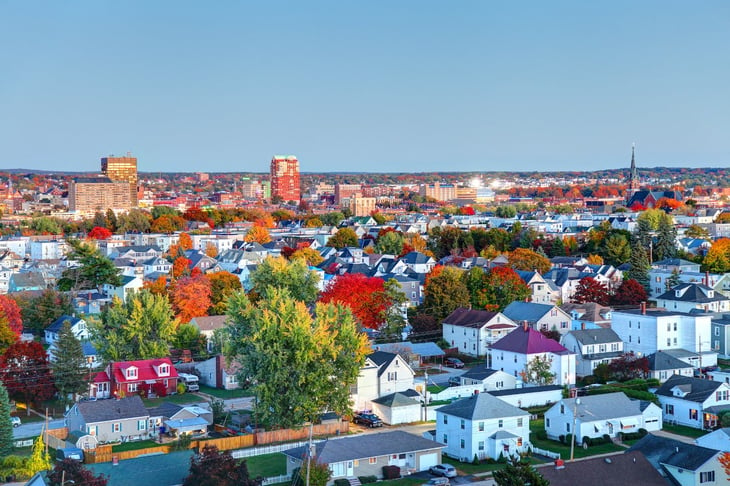
Image source: Getty Images.
- Estimated income-to-expense ratio: 1.179
- Cost-of-living index: 116.1
- Cost-of-living estimate: $77,703
- Median household income: $91,672
- Median home price: $454,100
- Population: 115,462
- Unemployment rate: 2.5%
Manchester is the largest city in New Hampshire, and it's considered one of the top affordable cities for young professionals, as well as older adults. The median age here is 36.7, and there's lots to do, with plenty of quality restaurants and cafes.
This city is also great for art lovers. The Currier Museum features works by Picasso, Monet, and many other famous artists. The Palace Theatre was built in 1914 and continues to offer regular live performances.
Manchester is expensive, with a cost of living 16.1% more than the average American household's expenses. But wages are high at 29.5% more than the national median, and unemployment is only 2.5%. This city's top three industries are:
- Healthcare and social assistance
- Manufacturing
- Retail trade
3. Hartford, Connecticut
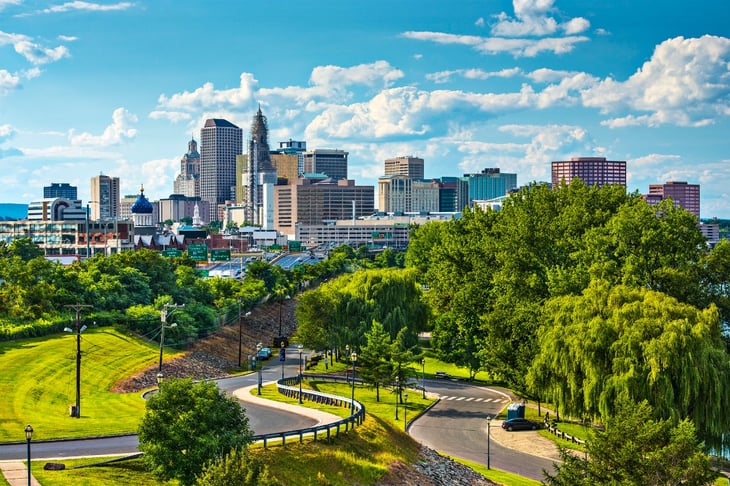
Image source: Getty Images.
- Estimated income-to-expense ratio: 1.157
- Cost-of-living index: 106.2
- Cost-of-living estimate: $71,077
- Median household income: $82,258
- Median home price: $318,200
- Population: 120,576
- Unemployment rate: 6.8%
Hartford is another city with a high average salary, as the median income comes in 16.2% higher than the median U.S. income. It's also not too expensive, with a cost of living 6.2% more than the national average and housing costs 1.6% less than average.
This city is one of the oldest in the nation. It's where you'll find the oldest public art museum, the Wadsworth Atheneum, and the oldest publicly funded park, Bushnell Park. It's also where Mark Twain wrote many of his most well-known books, and visitors can see where he lived at the Mark Twain House and Museum.
Hartford has a median age of 32.9, so it's a good fit for younger adults, assuming they can find work. Unfortunately, Hartford has the highest unemployment rate on this list at 6.8%, nearly twice the national rate. Its biggest industries are:
- Healthcare and social assistance
- Retail trade
- Transportation and warehousing
4. Framingham-Natick, Massachusetts

Image source: Getty Images.
- Estimated income-to-expense ratio: 1.156
- Cost-of-living index: 140.1
- Cost-of-living estimate: $93,766
- Median household income: $108,397
- Median home price: $559,900
- Population: 107,494
- Unemployment rate: 3.6%
Located in the Greater Boston area, Framingham and Natick are neighboring areas full of high earners. The median household income here is the highest on this list and an impressive 53.1% more than the national median.
This area is good for families, with lots of outdoor activities. The median age in Framingham is 38.9. Public schools are also highly rated, especially in Natick.
The salaries in Framingham and Natick balance out the cost of living, which is extremely high. It costs 40.1% more than the national average overall, and housing costs are 83.5% more than the national average. Unemployment is near the national rate at 3.6%, and the major industries are:
- Healthcare and social assistance
- Retail trade
- Educational services
5. Stamford, Connecticut
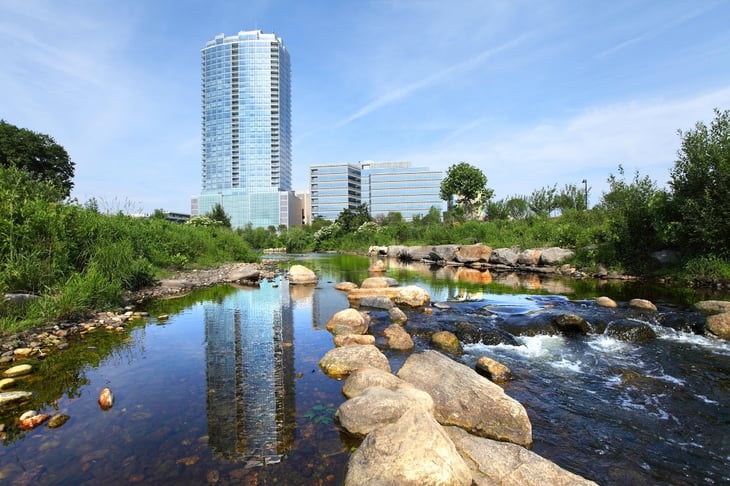
Image source: Getty Images.
- Estimated income-to-expense ratio: 1.155
- Cost-of-living index: 130.4
- Cost-of-living estimate: $87,274
- Median household income: $100,810
- Median home price: $621,100
- Population: 136,309
- Unemployment rate: 4.5%
Stamford is another city where incomes are high, beating the national median by 42.4%. That helps balance out a cost of living that's 30.4% more than the national average. Unfortunately, housing is especially expensive in Stamford whether you rent or buy. Its housing costs are 64.1% more than average.
For those who can afford it, Stamford has plenty to offer in terms of quality of life. There are several parks, and Mills River Park in downtown has regular community activities. It also has quite a few nightlife options and a strong arts scene, with Curtain Call being a popular place to catch a show.
The level of education is high in Stamford, with over half the population holding a bachelor's or graduate degree, and the median age is 37.9. Unemployment is greater than the national rate at 4.5%. The largest industries in Stamford are:
- Healthcare and social assistance
- Professional, scientific, and technical services
- Finance and insurance
6. Albany, New York

Image source: Getty Images
- Estimated income-to-expense ratio: 1.106
- Cost-of-living index: 105.7
- Cost-of-living estimate: $70,743
- Median household income: $78,272
- Median home price: $275,900
- Population: 98,617
- Unemployment rate: 3.8%
A city with a rich history, Albany is the capital of New York and the most affordable city in the state. The cost of living is only 5.7% more than the national average. Housing is relatively inexpensive, at least by New York standards, at 3.3% more than average.
This city is home to a large number of museums and historical sites. One of the highlights is the USS Slater, a restored Destroyer Escort that battled Nazi U-Boats during World War 2. Albany isn't just for history buffs, though. There are also parks, hiking trails, and restaurants to visit.
Young adults make up a large portion of the population here, and the median age is 30.7. The median income is 10.6% more than the national median, unemployment isn't too high at 3.8%, and the biggest industries here are:
- Healthcare and social assistance
- Public administration
- Educational services
7. Harrisburg, Pennsylvania

Image source: Getty Images
- Estimated income-to-expense ratio: 1.068
- Cost-of-living index: 102.9
- Cost-of-living estimate: $68,869
- Median household income: $73,559
- Median home price: $237,000
- Population: 50,135
- Unemployment rate: 5.7%
Harrisburg is the Pennsylvania state capital, and both its income and cost of living are a little above average. The median household income is 3.9% more than the national median. Cost of living is 2.9% greater than the national average.
This is another area with quite a bit of history behind it. It has plenty of museums and historical sites where residents can learn about the past, including the National Civil War Museum, Fort Hunter Mansion and Park, and the State Museum of Pennsylvania.
Harrisburg has a median age of 31.5, so the population is on the young side. The unemployment rate is high at 5.7%. This city's top industries by number of employees are:
- Healthcare and social assistance
- Retail trade
- Accommodation and food services
8. Burlington-Chittenden County, Vermont
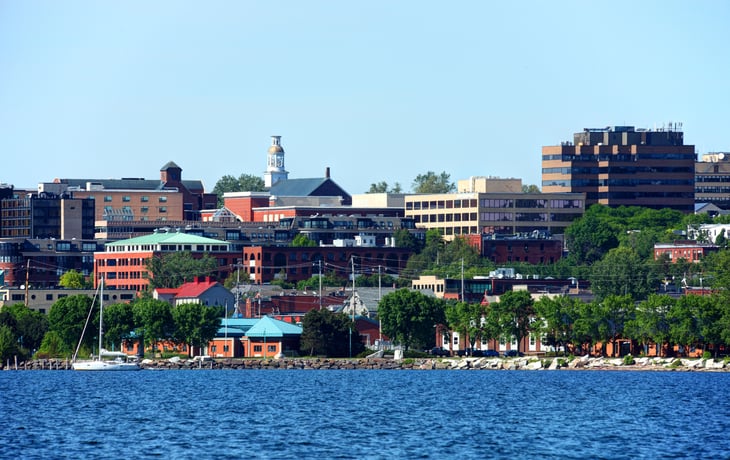
Image source: Getty Images
- Estimated income-to-expense ratio: 1.055
- Cost-of-living index: 115.9
- Cost-of-living estimate: $77,569
- Median household income: $81,852
- Median home price: $430,500
- Population: 44,781
- Unemployment rate: 2.0%
Burlington is a college town, with the University of Vermont and Champlain College both located here. Due to its large student population, it's the youngest city on this list with a median age of 27.1.
The median household income in Burlington is 15.6% above the national median. But it's expensive to live here, with the cost of living exceeding the national average by 15.9%. Housing costs are even more expensive at 32.6% greater than the national average.
To its credit, Burlington has the lowest unemployment rate on this list at just 2.0%. The biggest industries here are:
- Educational services
- Healthcare and social assistance
- Accommodation and food services
9. Newark-Elizabeth, New Jersey
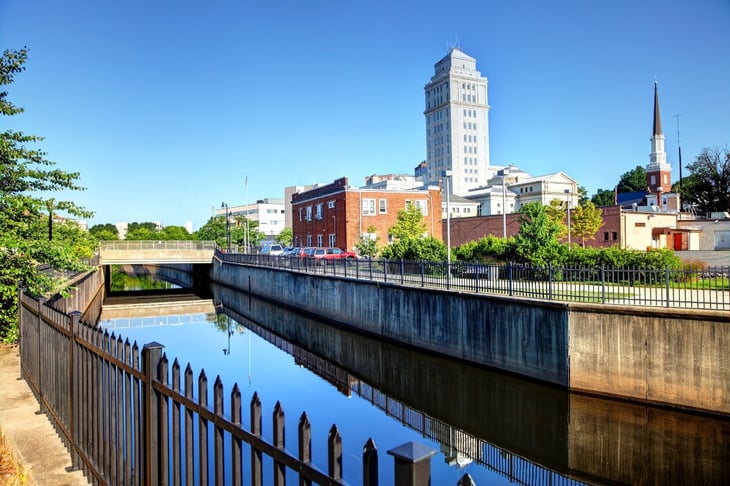
Image source: Getty Images.
- Estimated income-to-expense ratio: 1.047
- Cost-of-living index: 120.5
- Cost-of-living estimate: $80,648
- Median household income: $84,409
- Median home price: $538,500
- Population: 307,220
- Unemployment rate: 4.1%
The neighboring cities of Newark and Elizabeth have competitive wages that are 19.2% more than the national median. They have a mix of young adults and families, with median ages of 34.5 in Newark and 34.9 in Elizabeth.
Living expenses aren't cheap in this area, as they're 20.5% more than the national average overall. Housing is what tends to cost the most here, just like in most of the Northeast. The average home price is high, and housing costs overall are 52.2% above the national average.
The unemployment rate is also somewhat high at 4.1%. Ranked by number of employees, the top industries are:
- Healthcare and social assistance
- Transportation and warehousing
- Retail trade
10. Allentown, Pennsylvania
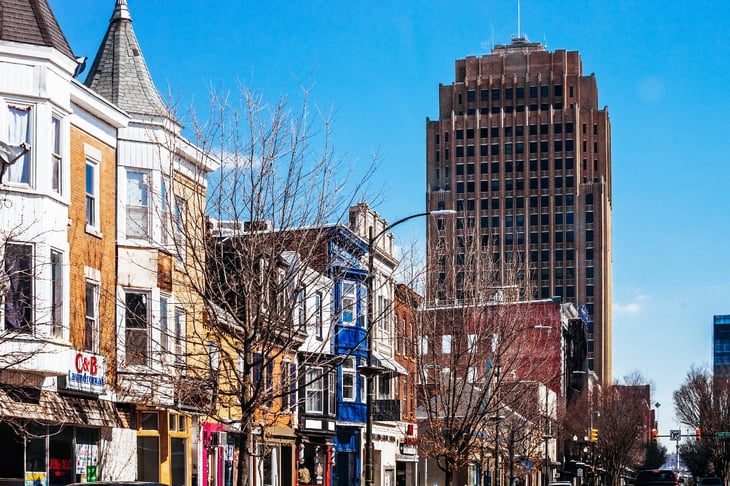
Image source: Getty Images.
- Estimated income-to-expense ratio: 1.021
- Cost-of-living index: 105.5
- Cost-of-living estimate: $70,609
- Median household income: $72,058
- Median home price: $299,800
- Population: 125,944
- Unemployment rate: 6.2%
Allentown is the third-largest city in Pennsylvania, after Philadelphia and Pittsburgh. Although the median household income is just 1.8% more than the national median, this is one of the more budget-friendly places to live in the Northeast. The cost of living is 5.5% more than the national average.
There's a diverse range of activities available in Allentown. Car aficionados will love the American On Wheels Museum. During the hot summer months, Dorney Park and Wildwater Kingdom is one of the most popular attractions. This is a younger city, with a median age of 31.2.
Unfortunately, Allentown has a very high unemployment rate of 6.2%. The major industries here are:
- Healthcare and social assistance
- Manufacturing
- Transportation and warehousing
Cheapest and most expensive cities in the Northeast
Erie, Pennsylvania is the cheapest city in the Northeastern United States with a cost-of-living index of 89.9, according to the Council for Community and Economic Research. Manhattan, New York is the most expensive at 228.0. A cost-of-living index of 100 represents the national average, which means Erie is 10.1% cheaper than average, and Manhattan is 128% more expensive.
You'll find the cheapest and most expensive cities in the Northeastern United States below. Keep in mind that the rankings for the cheapest cities are based only on cost of living. That means it's not an affordability ranking, because it doesn't factor in median income.
Cheapest cities in the Northeast
| City | Cost-of-living index |
|---|---|
| Erie, Pennsylvania | 89.8 |
| Wilkes-Barre, Pennsylvania | 91.2 |
| Scranton, Pennsylvania | 92.8 |
| Buffalo, New York | 95.2 |
| Vineland, New Jersey | 95.6 |
| Rochester, New York | 98.8 |
| Pittsburgh, Pennsylvania | 100.4 |
| Harrisburg, Pennsylvania | 102.9 |
| Utica-Rome, New York | 103.4 |
| Philadelphia, Pennsylvania | 104.5 |
Most expensive cities in the Northeast
| City | Cost-of-living index |
|---|---|
| New York (Manhattan), New York | 228.0 |
| New York (Brooklyn), New York | 168.7 |
| Boston, Massachusetts | 149.7 |
| New York (Queens), New York | 142.3 |
| Framingham-Natick, Massachusetts | 140.1 |
| Stamford, Connecticut | 130.4 |
| Newark-Elizabeth, New Jersey | 120.5 |
| Bergen-Passaic, New Jersey | 119.6 |
| Manchester, New Hampshire | 116.1 |
| Burlington-Chittenden County, Vermont | 115.9 |
Methodology
Each city's cost-of-living index was taken from the Council for Community and Economic Research's 2022 annual average cost-of-living index report.
The estimated cost of living in each city is calculated by multiplying the city's cost-of-living index score by the median annual household expenditure across the United States. This number is an estimate of median expenditures per household in the city. Household expenditure data is from the 2021 Consumer Expenditure survey.
The estimated income-to-expense ratio is calculated by dividing the median household income in the city by the cost-of-living-estimate for the city. A higher estimated income-to-expense ratio score means the city is more affordable as the median household income there is above the cost-of-living estimate. Income data is from the 2021 American Community Survey.
Region designations follow the Census Bureau's categorization.
Sources
- Council for Community and Economic Research (2023). "2022 Annual Average Cost of Living Index Report."
- Data USA (2023). Various city pages.
- National Association of Realtors. "Metropolitan Statistical Areas Q4 2022."
- Realtor.com. Various city pages.
- U.S. Bureau of Labor Statistics. "Civilian Unemployment Rate."
- U.S. Bureau of Labor Statistics. "Consumer Expenditure Survey."
- U.S. Bureau of Labor Statistics. "Local Area Unemployment Statistics."
- U.S. Census Bureau. "American Community Survey."
- U.S. Census Bureau. "Income in the United States: 2021."
- World Population Review (2023). Various city pages.
Our Research Expert
We're firm believers in the Golden Rule, which is why editorial opinions are ours alone and have not been previously reviewed, approved, or endorsed by included advertisers. The Ascent does not cover all offers on the market. Editorial content from The Ascent is separate from The Motley Fool editorial content and is created by a different analyst team.